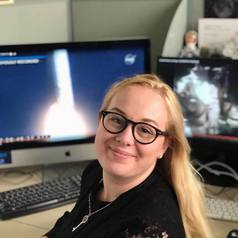On its first try, China's Zhurong rover hit a Mars milestone that took NASA decades


This article was originally published at The Conversation. The publication contributed the article to Space.com's Expert Voices: Op-Ed & Insights.
Sara Webb, PhD candidate in Astrophysics, Swinburne University of Technology
Rebecca Allen, Swinburne Space Office Project Coordinator | Manager Swinburne Astronomy Productions, Swinburne University of Technology
China's Zhurong rover landed safely on Mars on May 15, making China only the third country to successfully land a rover on the red planet.
More impressively still, China is the first Mars-going nation to carry out an orbiting, landing and rovering operation as its first mission.
Planetary scientist Roberto Orosei told Nature China is "doing in a single go what NASA took decades to do," while astrophysicist Jonathan McDowell described China's decision to include a rover in its maiden Mars outing as a "very gutsy move."
Related: Hear the 1st sounds from China's Mars rover Zhurong and watch it drive in new video
Breaking space news, the latest updates on rocket launches, skywatching events and more!
Congratulations to CNSA’s #Tianwen1 team for the successful landing of China’s first Mars exploration rover, #Zhurong! Together with the global science community, I look forward to the important contributions this mission will make to humanity’s understanding of the Red Planet. pic.twitter.com/KexElIu8OHMay 15, 2021
Where did it land?
Zhurong, named after the god of fire in Chinese mythology, separated from the Tianwen-1 orbiter and touched down close to the site of previous NASA missions, on a vast plain called Utopia Planitia.
This area of Mars was formed billions of years ago, when a martian meteorite smashed into the planet’s surface. The surrounding area is largely featureless, covered mostly in volcanic material.
Zhurong is not the first rover to explore this region. In 1976, NASA's Viking 2 lander touched down further north within the Utopia Planitia basin, returning high-resolution images of the martian surface and analyzing soil samples.
The Viking 2 lander lacked the ability to investigate any further than its initial landing site. But the Zhurong rover should be well equipped to roam farther afield during its mission.
What will it do?
The mission’s three-month scientific program will begin once the Zhurong rover disembarks from the landing craft and begins its journey across the martian surface. The 240-kilogram, six-wheeled rover is equipped with six individual scientific instruments, and has four large solar panels, giving it the appearance of a "blue butterfly."
Zhurong's design, instruments and technology on board Zhurong are comparable to those on board NASA's twin rovers Spirit and Opportunity, which touched down in January 2004. Although Zhurong is not at the cutting edge of current space exploration technology, the sheer speed of this program’s development since its initiation in 2006 is awe-inspiring.
Like the many Mars rovers before it, Zhurong will probe this alien planet’s environment, and search for signs of water ice on the surface.
The mission is expected to survey four aspects of its local environment:
- topography and geological structure
- soil structure and possible presence of water ice
- chemical composition, minerals and rock types
- physical characteristics of the atmosphere and the rocky surface.
Zhurong will thus help build a more complete geological picture of the Red Planet's history. And, in a genuine first for Martian exploration, it is equipped with a magnetometer to measure the planet's magnetic field. This is an important study that will help address why Mars has lost much of its atmosphere, leaving its landscape so barren.
China's growing space presence
The Tianwen-1 mission is just one of an impressive list of accomplishments by the China National Space Administration in the past year. Its other feats include launching dozens of Long March rockets, each with multiple payloads, including that of the Chang'e 5 lunar probe, which brought moon rocks back to Earth for the first time since the end of NASA's Apollo program in the 1970s.
Last month, China launched the first stage of its Tiangong space station, which next year is set to become the world's second long-term home for humans in space. The momentous launch didn't go off without a hitch, however, as debris from the launch vehicle made an uncontrolled re-entry back to Earth, eventually splashing down in the Indian Ocean.
Thankfully no one was hurt in that incident, but it is a timely reminder that China's accelerating pace of space missions and rocket launches need to be carefully managed.
This year of activity has solidified China's powerful presence in space, and we are only seeing the beginning of its ambitious future. By 2045, China hopes to become a leading space power, as outlined in the 2018 Aerospace Science and Technology Corporations route map.
In the coming years we can look forward to seeing China launch crewed missions to the Tiangong space station, and in the coming decades can expect to see China join other spacefaring nations in missions back to the moon and Mars.
This article is republished from The Conversation under a Creative Commons license. Read the original article.
Follow all of the Expert Voices issues and debates — and become part of the discussion — on Facebook and Twitter. The views expressed are those of the author and do not necessarily reflect the views of the publisher.

Sara Webb is an Astrophysics/ML postdoctoral researcher and science communicator based at Swinburne University. She spends her days solving data challenges with machine learning and coordinating student-led research projects to the International Space Station. In her PhD she was chasing the fastest bursts in the Universe, caused by the most energetic stellar events. This research took her in many amazing directions, from hunting gravitational wave counterparts to investigating the largest stellar flares.
